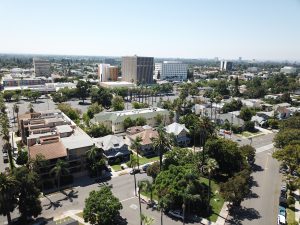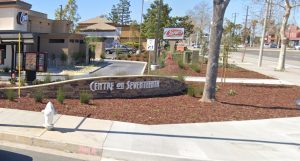
Calle Cuatro Plaza
At the intersection of 4th and French Streets, Calle Cuatro Plaza is a public space that provides a forum for a range of community activities in Downtown Santa Ana. The plaza has been enhanced with design features that welcome people, such as seating areas, a stage, murals, and other accessibility features.
Santa Ana Artists Village
Looking west down the 2nd Street Promenade, Santa Ana’s Artists Village is one of Orange County’s most vibrant arts districts. It is a thriving home to art galleries, studios, creative businesses, and restaurants in historic Downtown Santa Ana. The Artists Village features restored historical brick buildings alongside ornate Spanish architecture on streets lined with fountains, palm trees, and sidewalk cafes.
Historic French Park
A view of the French Park neighborhood looking southwest toward Downtown Santa Ana. The neighborhood, first marketed as “Santa Ana East,“ was plotted in 1877 in anticipation of the railroad line extension. The streets in the original 160-acre tract were laid out parallel to the railroad tracks and at an angle to both the original townsite and the majority of subsequent development in the city. Areas where the two street patterns meet result in irregularly shaped blocks, like the triangular French Park, pictured above.Urban Design Element

Photo by Essex Apartment Homes
MacArthur Place
MacArthur Place offers an urban environment where housing and services are integrated in a collection of tall office buildings and residential towers. The southern portion of MacArthur Place surrounds a central lake that provides a scenic amenity with pedestrian linkages for all users. The area's perimeter is characterized by landscaped setbacks and structures increasing in height as you move east from Main Street.
17th and Tustin
The corners around the intersection of 17th Street and Tustin Avenue incorporate consistent visual enhancements, including signage, landscaping, and public art.
Major Landmarks
Many major landmarks, like the the Chiarini Fountain shown here, the old Orange County Courthouse, the Spurgeon Building, the zoo, and Santa Ana College, are well-established community assets that reflect the city's history and communicate the city's current identity and role in the region.
Local Landmarks
Local landmarks can be anything that helps to orient people within a district and communicates the local identity. Public art, like the "Santa Ana" mural above Calle Cuatro Plaza, can function as both a local landmark that helps to orient people in the city and as a placemaking tool.